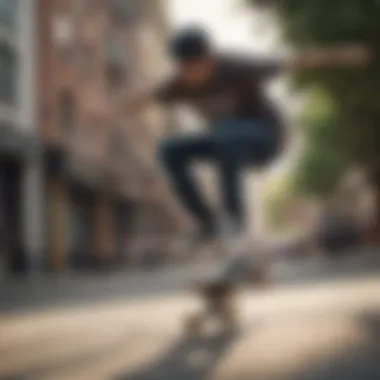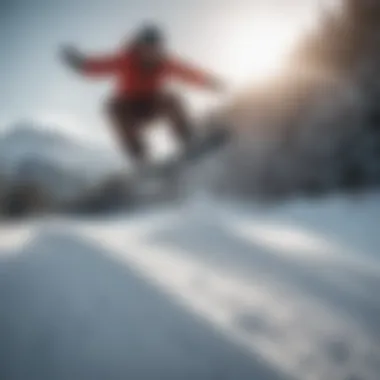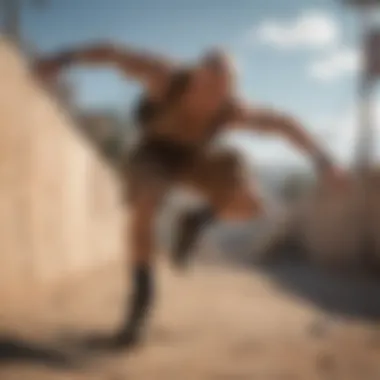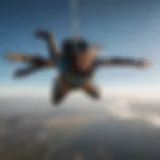Mastering Ollies: Techniques and Insights for Extreme Sports


Intro
Understanding ollies is crucial for anyone involved in extreme sports, especially skateboarding and snowboarding. This foundational trick serves as a stepping stone to many advanced maneuvers. Mastering the ollie not only enhances your skills but also deepens your appreciation for the precision and control required in these sports. In this article, we will take a detailed look at the various dimensions of oollies, focusing on techniques, common mistakes, and advanced variations.
Equipment and Gear
Overview of essential gear for extreme sport
Before diving into ollies, it is important to have the right equipment. Fundamental gear includes skateboards, snowboards, and protective equipment. This is especially important for newbies. A skateboard should be sturdy yet flexible, allowing for the right amount of pop during an ollie. For snowboarding, a well-matched board to your skill level is necessary for control.
In addition to boards, protective gear like helmets, knee pads, elbow pads, and wrist guards is vital. They provide safety and confidence. Among the essential gear is footwear as well. Specific skate shoes, such as those from Vans or Nike SB, offer grip and support when performing ollies.
Detailed descriptions of top brands and recommended products
When selecting gear, consider well-established brands. For skateboarding, companies like Element, Almost, and Baker offer reliable boards. When it comes to snowboarding, Burton and Ride are leading options. Proper shoes can greatly influence your performance, and brands such as Adidas and DC provide excellent choices.
Tips on maintenance, upgrades, and new advancements in equipment
Maintenance is key for longevity in equipment. Regularly check your board for cracks or splits. Keeping the wheels clean and replacing worn-down components helps maintain performance. Upgrades can also benefit your experience. Consider trying out different grip tapes or custom board designs to express your individuality.
Techniques and Training
Breakdown of advanced skills and techniques for mastering extreme sport
An ollie is more than just a jump; it requires specific techniques for execution. The crucial components involve weight distribution, timing, and board control. Start with your back foot on the tail of the skateboard or snowboard. As you compress down, shift your weight backward. When you extend your legs, pop the tail down while dragging your front foot up. This motion helps lift the board off the ground. The key is to ensure that your landing is smooth, with knees slightly bent.
Training exercises and routines to improve strength, agility, and endurance
To enhance your ability to perform ollies, engage in targeted training routines. Jump squats can boost your explosive power. Balance exercises, such as standing on one foot or using a balance board, are effective to improve overall control. Cardiovascular training is also essential; running or cycling can develop endurance.
Insight from professional athletes and trainers on honing skills
Professional athletes often emphasize practice. One suggestion is to break down the ollie into smaller parts. Focus on each element individually before integrating them into the complete maneuver. Also, watch video tutorials online or attend workshops in your community to learn from experienced instructors.
Safety and Risk Management
Importance of safety protocols and precautions in extreme sport
Safety is a priority in extreme sports. Establishing safety protocols will help mitigate risks associated with ollies. Always wear your protective gear, and encourage friends to do the same. Educating yourself about the environment you are skating or snowboarding in is also essential; knowing where potential hazards lie can make a big difference in safety.
Common risks and potential hazards to be aware of
Practicing ollies comes with inherent risks. Falling is common; however, understanding how to fall safely can reduce the chance of injury. Avoid attempting ollies in crowded areas or on uneven surfaces, as these conditions can increase the chance of accidents.
Strategies for risk mitigation and emergency preparedness
Having a first aid kit on hand is critical, as it allows immediate response to minor injuries. Furthermore, it is wise to practice ollies in controlled environments—perhaps at skate parks—before attempting them in more unpredictable settings. Getting a buddy to spot you, especially when trying advanced variations, can be very helpful.
Events and Competitions
Upcoming events, competitions, and championships in the extreme sport community
A vibrant event calendar exists for those passionate about skateboarding and snowboarding. Keep an eye out for local competitions or larger tournaments. Websites and community boards provide schedules and information for events. Participating in these competitions enables you to test your skills and receive invaluable feedback from experienced judges.
Profiles of top competitors and teams in the sport
The extreme sports community is filled with notable athletes. Following leaders like Nyjah Huston in skateboarding or Shaun White in snowboarding can offer inspiration. Their dedication and progression in the sport serve as motivation.
Coverage of recent events and highlights from key competitions
Staying updated on recent events through platforms like Reddit or even dedicated sports sections in traditional media helps keep your finger on the pulse of the extreme sports scene. Watching highlight reels and recaps from major competitions can provide insights into advanced ollie techniques used by top athletes.
Lifestyle and Community
Features on lifestyle aspects related to extreme sport culture
The extreme sports culture is unique. It often emphasizes community and individuality. Those involved embrace a lifestyle that values both adrenaline and creativity. Sharing tricks and tips among peers creates a supportive environment, where everyone strives to improve.
Tips for balancing extreme sports with a healthy lifestyle and mental well-being
Maintaining a healthy balance between training and rest is crucial. Make sure to allocate time for recovery, especially for your muscles and joints. Nutrition also plays an important role; a diet rich in proteins and essential nutrients fuels the body for active days.


Furthermore, find time for other interests outside of extreme sports. This can prevent burnout and enhance well-being. Engaging in different activities fosters a balanced perspective, helping you enjoy the sport even more.
Preamble to Ollies
Understanding the ollies is essential in the realm of extreme sports. This maneuver acts as a cornerstone for many complex tricks and forms the basis of advanced skills in skateboarding and snowboarding. When mastering ollies, practitioners gain not only the ability to perform impressive jumps but also a deeper comprehension of board dynamics. This knowledge can enhance performance across various terrains and styles.
Definition and Importance
The ollie is defined as a technique where the rider leaps into the air by simultaneously popping the tail of the board down while dragging the back foot upward. It is a simple yet powerful move that enables skateboarders and snowboarders to elevate their boards off the ground without the aid of any ramps or obstacles. The importance of the ollie cannot be overstated; it serves as the foundation of many advanced tricks, such as kickflips and grinds. Moreover, mastering the ollie improves overall board control, which is essential for both safety and performance.
Historical Context
Historically, the ollie emerged from the evolution of skateboarding in the late 1970s. Alan Gelfand, known as "Alf," is credited with inventing this pivotal maneuver. Initially performed on flat ground, the ollie quickly gained popularity, paving the way for subsequent trick development. As skateboarding evolved, so did the ollie, and it became integral to the sport’s culture. The ollie transitioned into snowboarding when the sport gained traction in the 1980s. Today, it is a fundamental technique employed across multiple extreme sports, symbolizing the creativity and innovation that characterize the community.
"The ollie is more than just a jump; it represents a skillset that unlocks a world of possibilities in extreme sports."
As we delve deeper into the technical aspects, step-by-step guides, and common mistakes associated with ollies, a well-rounded understanding will emerge, allowing enthusiasts to refine their skills and appreciate the art and science underpinning this fundamental trick.
Technical Aspects of the Ollies
The technical aspects of ollies are crucial, serving as the backbone for executing this essential maneuver in extreme sports. Understanding these elements can elevate a practitioner's performance and reduce the likelihood of making errors. Several factors contribute to the successful execution of an ollie. These include basic mechanics, weight distribution, timing principles, and board control techniques. Each element plays a vital role in the overall effectiveness and safety of the ollie.
Basic Mechanics
The basic mechanics of the ollie involve a simple yet effective sequence of actions: the rider crouches down, uses their back foot to pop the tail of the board while sliding their front foot up the deck, and finally jumps. This coordination helps create vertical lift. The ollie does not need ramps or obstacles; it can be performed on flat ground. This aspect highlights its versatility, making ollies accessible to beginners.
Important variables include the rider's stance, speed, and foot positioning. Nailing these mechanics lays a strong foundation for more advanced tricks. A proper ollie also allows for improved control and stability when landing, which is essential for more complicated maneuvers.
Weight Distribution
Weight distribution is a fundamental consideration in performing ollies. Proper weight shifting ensures the board responds appropriately during the execution phase. Riders need to maintain a slightly forward position on the board while crouching. As the pop occurs, the back foot applies pressure on the tail, while the front foot helps guide the board upwards.
Misplacing weight can lead to an imbalance. If the weight is too far back, the rider risks losing control, possibly resulting in falls. Conversely, leaning too far forward can cause the front to dive, leading to poor landings. Understanding the delicate balance of weight is crucial for success in both simple and advanced ollie variants.
Timing Principles
Timing is a decisive element in performing ollies. The sequence of movements must be executed in harmony to achieve optimal height and control. Initiating the pop at the moment when the rider jumps is important. A well-timed ollie lifts the board with the rider, creating an almost fluid motion.
Missed timing can lead to a variety of issues. For example, a premature pop can result in the board not leaving the ground altogether. Conversely, an overly delayed pop may cause the board to shoot out from beneath the rider, leading to a hard fall. Training one's timing can significantly improve not only the ollie execution but also the performance of other tricks.
Board Control Techniques
Board control techniques are paramount in the execution of ollies. Effective control allows the rider to manipulate the board in mid-air and during landing. This includes proper foot positioning during the ollie, which should place the front foot across the bolts. It allows the rider to push down or guide the tail up with the back foot.
Riders must also be aware of the board's orientation while airborne. A stable ollie exhibits a straight trajectory with minimal spinning or wobbling of the board. Mastery of board control paves the way for complex tricks that can be performed smoothly.
"Executing an ollie is not just about jumping; it’s about understanding physics applied in motion."
Step-by-Step Guide to Performing an Ollie
Understanding the step-by-step process of performing an ollie is fundamental for anyone aiming to progress in extreme sports. This technique serves as a foundation, impacting not only the execution of more complex maneuvers but also enhancing overall skill levels in skateboarding and snowboarding. The importance of mastering the ollie lies in its versatility and broad application across various tricks. Each phase—preparation, execution, and landing—requires precise movements and mental focus, which together foster a deeper relationship with the board and the sport. In this guide, we will break down these phases to equip enthusiasts with practical skills needed for improvement.
Preparation Phase
Before executing an ollie, adequate preparation is paramount. This phase involves several key elements which contribute to the successful execution of the trick.
- Stance: Ensure your feet are positioned properly on the board. The back foot should be placed near the tail, while the front foot is positioned a bit further up, aiming for around a 45-degree angle.
- Balance Check: Take a moment to center your weight over the board. Good balance is essential here.
- Mental Readiness: Visualizing the ollie can be very beneficial. Picture each step of the trick in your mind. This mental rehearsal can help to ease anxiety and improve performance.
- Speed Control: Begin rolling at a moderate speed. Too fast might make control challenging, while too slow can hinder the necessary lift off the ground.
Focusing on these aspects prepares the rider both physically and mentally for the next step. A solid preparation phase lays a strong foundation for the ollie's success.
Execution Phase
The execution of the ollie is where the trick starts to come to life. Timing of movements is critical during this stage:
- Pop the Tail: Use your back foot to push down on the tail of the board. This action creates the lift necessary to leave the ground.
- Jump: Simultaneously, use your body to jump upward, pulling your knees toward your chest. This motion generates the necessary height for the ollie.
- Slide Up: As you jump, drag the front foot upwards along the grip tape. This action helps to level the board in mid-air. The upward slide is critical for achieving a flat, controlled ollie.
- Focus on Smooth Motion: Ensure all movements are fluid. Any hesitation can lead to mistakes mid-air.
Executing these steps smoothly contributes significantly to the overall control and aesthetic of the ollie.
Landing Phase
Proper landing technique can make a significant difference in the overall success of the ollie. Here's what to consider:
- Eye on the Landing Spot: Keep your gaze focused on where you plan to land. This will help align your body's movements accordingly.
- Absorb the Impact: Bend your knees upon landing. This action absorbs the shock and helps maintain balance.
- Steady Balance: Make sure your weight is evenly distributed across the board. If the weight shifts excessively, it might lead to falls or loss of control.
- Look to Transition: After landing, prepare for the next move or trick. The ollie can set you up for numerous other maneuvers, so transition smoothly.


Mastering each of these phases requires patience and practice. Continuous engagement with each element can lead to substantial improvement over time.
Identifying and executing these steps creates a coherent approach to performing an ollie, enabling practitioners to refine their skills effectively. The cumulative knowledge from each phase enhances one's performance in extreme sports, fostering an environment of growth and development.
Common Mistakes in Performing Ollies
Understanding the common mistakes in performing ollies is crucial for both beginners and experienced riders. Errors can halt progress and lead to frustration, not to mention increased risk of injury. By recognizing and correcting these mistakes, practitioners can refine their techniques, boost performance, and enjoy their time on the board more fully.
Misjudging Timing
Timing is one of the critical elements in executing a successful ollie. Misjudging this aspect can result in a failed attempt or, worse, an unstable landing. The ollie consists of a pop and scoop that must occur at precisely the right moment. Practitioners often think they need to jump high to clear an obstacle, which leads to premature or delayed popping of the tail. This mistake often stems from a lack of rhythm or understanding of the fluidity required. To avoid this problem, riders should practice their timing with small jumps. Gradually increasing difficulty while maintaining a focus on timing will help develop a keen sense of when to pop and jump together.
Incorrect Weight Shifting
Weight distribution plays a significant role in how an ollie is performed. Incorrect weight shifting can result in loss of control and an ineffective jump. Many riders shift too much weight onto the back foot before jumping. This can cause the front of the board to dip, ultimately leading to a very low ollie. Alternatively, shifting weight too far forward may result in the rider falling forward upon landing. Practicing the weight shift at slow speeds can bring awareness to this crucial part of the maneuver. Riders should aim for a balanced position, where both feet share weight evenly, each contributing to the lift and stability of the board.
Board Position Errors
The positioning of the board during an ollie can make or break the maneuver. Mistakes occur when the rider does not align their feet on the tail properly. If the back foot is too close to the edge, it can lead to skidding or failing to make a clean pop. Conversely, placing the back foot too far can prevent effective leverage. Riders should pay attention to foot placement, ensuring their back foot is positioned near the tail, while the front foot is placed just behind the midpoint. Practicing ollies on various surfaces can also help identify the right positioning in varied conditions, refining control and board feel.
"Recognizing and learning from mistakes is the foundation of mastery in ollies and any extreme sport."
By focusing on these common pitfalls, riders can improve their ollies significantly. Addressing misjudging timing, incorrect weight shifting, and board position errors is vital for any extreme sports enthusiast. Proper practice and awareness can elevate skills and enhance the overall experience in skateboarding or snowboarding.
Variations of the Ollies
Exploring the variations of the ollie is crucial for understanding its role in extreme sports. Each variation serves different purposes and can add versatility to a rider's skillset. Learning these variations can also enhance creativity, allowing athletes to adapt their techniques based on their environment and personal style. This section elaborates on three specific ollie variations, emphasizing their importance and distinct characteristics within skateboarding and snowboarding.
The Ollie North
The Ollie North is a dynamic variation that elevates the traditional ollie. This maneuver involves a front-foot lift that allows the rider to shift weight forward while performing the jump. It is particularly useful for traversing obstacles that require a quicker elevation.
This technique not only showcases a rider's agility but also adds flair to any routine. Riders execute the Ollie North by popping up while leaning slightly forward.
To master this move, a rider should focus on:
- Proper timing when raising the front foot
- Utilizing the rear foot effectively to pop the board
- Maintaining balance throughout the lift
Regular practice helps build confidence in this variation and contributes to an overall increase in skills.
The Ollie to Fakie
The Ollie to Fakie is another essential variation that brings an additional layer of complexity to standard ollies. In this maneuver, the rider performs an ollie and lands with their back foot shifted to the tail of the board, facing backwards. This shift allows for a smooth transition into riding fakie, which is riding in reverse.
This approach not only enhances the rider’s versatility but also serves as a bridge to many advanced tricks. Key components of executing an Ollie to Fakie include:
- Practicing how to shift body weight effectively
- Developing a keen sense of balance upon landing
- Gaining familiarity with riding fakie before attempting this ollie variation
Focusing on these aspects will significantly improve the execution of this trick and allows riders to blend various styles in their performance.
The Sideswipe Ollie
The Sideswipe Ollie stands out as a visually striking variation that draws attention. This ollie involves a horizontal board motion during the lift, which can be executed over obstacles or simply in the air.
This approach adds a unique flair, making it popular among advanced snowboarders and skateboarders. To effectively perform a Sideswipe Ollie, riders should concentrate on:
- Lifting the board sideways while ensuring proper pop
- Ensuring mid-air stability to maintain control
- Developing strong board awareness to land accurately
Mastering this move not only enhances the rider's repertoire but also encourages fluidity in transitions. Incorporating the Sideswipe Ollie into routines can elevate performances significantly, showcasing creativity and skill.
The Role of Ollies in Various Extreme Sports
Ollies serve as a fundamental technique in a variety of extreme sports. They connect various tricks and maneuvers while also enhancing a rider's ability to adapt to different environments. Understanding the role of ollies across diverse sports helps practitioners appreciate the technique's versatility and benefits. The key aspects include techniques involved, the foundational nature of ollies, and their contributions to individual sports.
Skateboarding
In skateboarding, ollies are essential for performing tricks. This move allows skaters to elevate their board from the ground without any external assistance. Once a skater can ollie effectively, they can tackle obstacles such as curbs, gaps, and ramps. Skaters transition from flat ground tricks to more advanced maneuvers, like kickflips and pop shuvits, that are all built on the ollie foundation.
In addition, ollies contribute to style and fluidity in skateboarding. The ability to link multiple tricks through smooth ollies showcases technical skill and control. Many street skaters consider the ollie to be the gateway to expressing creativity in their riding.
Snowboarding
In snowboarding, ollies allow riders to lift the board off the ground, essential for navigating terrain parks and natural features. The ollie technique facilitates jumping over obstacles, whether they are smaller natural elements or larger park structures. Snowboarders rely on ollies when launching off jumps, performing grabs, and incorporating spins into their routines.


Snowboarders also benefit from ollies in adjusting their approach to varying snow conditions. By modifying their weight distribution and timing, they can perform ollies on different types of terrain, enhancing overall riding experience. It teaches riders to read terrain effectively, contributing to their overall safety and performance.
BMX Riding
The role of ollies in BMX riding is profound. Riders use ollies to jump over obstacles and perform tricks while maintaining control of their bikes. This foundational skill allows BMX athletes to explore their limits in both street and park settings. Without the ollie, many popular tricks, like barspins and tailwhips, would not be feasible.
Ollies in BMX also aid in navigating different jumps and ramps. They enable riders to adjust their height and trajectory during tricks. This adaptability is crucial when executing complex lines in competitions.
Parkour Applications
In the realm of parkour, ollies present unique applications. While parkour is rooted in fluid movement, effective jumping techniques are vital. Practitioners employ the ollie to traverse gaps and clear obstacles effectively. Though this technique is inspired from skateboarding, its principles translate well into urban environments.
The ollie emphasizes the importance of timing and coordination in parkour. Practitioners learn to assess distances and adjust their movements accordingly, improving their overall agility. This skill is crucial for conquering both urban settings and outdoor environments.
Understanding ollies across various platforms showcases their importance in developing skills that extend beyond one sport.
Safety Considerations
In extreme sports, safety is a vital consideration. Engaging in activities like skateboarding and snowboarding comes with inherent risks. Focusing on safety can greatly reduce the chance of injuries. It is essential to understand the importance of protective gear and conduct thorough risk assessments to promote safe practices while performing ollies and other maneuvers.
Protective Gear
To ensure safety during extreme sports, various types of protective gear are necessary. This gear minimizes the impact of falls and collisions, and it can make a significant difference in preventing injuries. The key elements of protective gear include:
- Helmets: A properly fitting helmet can protect the head during falls. It absorbs impact energy and reduces the risk of concussions.
- Wrist Guards: Wrists are particularly vulnerable during falls. Wrist guards help to prevent fractures and sprains by providing additional support.
- Knee and Elbow Pads: These pads safeguard joints from abrasions and impacts. They are often crucial for maintaining joint integrity while practicing new techniques.
- Footwear: Strong and well-designed shoes give the necessary grip and support for performing ollies safely. Proper footwear can enhance performance and minimize injuries.
- Padded Shorts: For snowboarders, especially, padded shorts can reduce injuries to the hips and tailbone during falls.
All skaters and boarders should prioritize wearing the appropriate protective gear tailored to their respective sport.
Risk Assessment
Conducting a thorough risk assessment is vital for anyone involved in extreme sports. Assessing the environment and personal skills helps identify possible hazards that could lead to accidents or injuries. Considerations for effective risk assessment include:
- Terrain Evaluation: Inspect the surface where you will perform ollies. Uneven ground, debris, or obstacles can pose significant danger. Identify potential hazards before attempting a maneuver.
- Skill Level: Understand your own abilities. Attempting advanced techniques beyond your skill level increases the risk of injury. It is essential to practice skills progressively, ensuring complete mastery before moving on.
- Weather Conditions: Weather can affect performance. Wet or icy conditions can lead to slips and falls. Always check the weather before heading out.
- Surroundings: Be aware of others in the area, whether they are fellow athletes or bystanders. Collisions can happen if space is limited.
- Emergency Preparedness: Have a plan for potential accidents. Know what to do in case of injury, and ensure access to first-aid supplies.
"Safety does not come from luck; it comes from careful planning and preparation."
By prioritizing safety through protective gear and risk assessment, extreme sports enthusiasts can focus on improving their skills. It allows them to enjoy the thrilling experience of ollies with a reduced chance of injury.
Continuous Improvement and Training
Continuous improvement and training are crucial for anyone involved in extreme sports, especially when it comes to mastering ollies. This aspect of practice focuses on sustaining growth and refinement of skills. It not only helps in achieving technical proficiency but also fosters a mindset geared towards long-term success. Practitioners can gain various advantages through a consistent approach in their training regimes.
First, through regular training, one can enhance muscle memory. Repetition of techniques allows for smoother execution over time. This leads to better performance during intense sessions or competitions. Moreover, the learning curve can be drastically improved by engaging in targeted practice sessions that focus on specific components of an ollie, such as timing or weight distribution.
Another essential element of continuous improvement is the incorporation of goal-setting strategies. Goals provide direction and motivation. By establishing clear objectives, one can monitor progress effectively. Setting both short-term and long-term goals keeps enthusiasts engaged and aware of their growth trajectory. It fosters a sense of accomplishment and accountability.
Also, adapting to different environments is vital for improvement. Practicing ollies in varying terrains or under changing conditions can significantly enhance one’s adaptability and board control. This versatility can prepare athletes for diverse situations they may encounter.
The pursuit of continuous improvement in ollies cultivates not only skill but also a deeper appreciation for the technique and the sport itself.
Practice Methods
Effective practice methods play a crucial role in mastering ollies. Engaging in structured sessions yields better results than random attempts. A suggested practice routine includes warming up to address flexibility and strength. This can minimize injuries and prepare the body for rigorous activity.
- Drills: Focus on high repetition of each ollie component. For example, concentrate on the pop and drag movements separately before combining them.
- Video Review: Record practice sessions and review them critically. This provides visual feedback and helps in recognizing areas for improvement.
- Peer Review: Skate or snowboard with friends who can provide constructive feedback. Collaboration often leads to new insights or techniques.
- Experimentation: Try variations of the ollie or practice on different terrains. This exploration leads to discovering what works best for individual styles.
Consistency in these methods ensures steady progress and aids in identifying which techniques resonate most.
Feedback and Self-Analysis
Receiving feedback and conducting self-analysis are integral to the training process. Immediate feedback allows for quick adjustments. Participating in community forums like reddit.com or attending clinics can offer external perspectives on one’s performance. Engaging with seasoned athletes can also illuminate new training approaches.
Self-analysis complements external feedback. Athletes should regularly reflect on their performances. Asking critical questions related to timing, form, or control can lead to substantial insights.
- Journals: Keeping a practice journal helps in tracking improvements and noting challenges faced during sessions.
- Goal Reevaluation: Regularly reassess goals, ensuring they remain relevant and achievable. This keeps motivation high.
- Focus Areas: After each session, identify a specific area for improvement. Concentrating on one aspect at a time is often more effective.
- Celebrate Achievements: Recognizing progress, no matter how small, enhances the journey of learning.
Integrating these feedback and analysis processes leads to informed adjustments in training habits, ultimately improving the ollie technique.
Closure
The conclusion serves as a critical reflection on the content presented throughout the article regarding ollies. It synthesizes the key techniques, insights, and nuances discussed within the various sections, reemphasizing the fundamental importance of mastering the ollie.
Understanding the ollie is not only pivotal for practitioners of extreme sports but also enhances the overall experience of engaging in these activities. The reader is reminded that the ollie is a foundational maneuver that underpins many advanced techniques. By mastering the ollie, an athlete improves their overall skill level, allowing for smoother transitions and greater creativity in their performance.
Key Elements of the Closure:
- Reiteration of Importance: The ollie is not just a trick; it is a building block for all subsequent movements. Its execution defines one’s capability in skateboarding, snowboarding, and even BMX riding.
- Benefits Overview: Mastering the ollie enables participants to explore a range of complex variations, contributing to the development of their personal style and confidence. It acts as a gateway to more advanced tricks.
- Considerations for Practice: Practitioners should take into account the importance of safety equipment and progressive training methods, as highlighted earlier in the article. Taking time to understand weight distribution and board control will greatly minimize the risk of injury during practice.
The importance of community within these sports is also worth noting. Engaging with a network, such as through platforms like Facebook and Reddit, can provide insights and feedback, fostering a supportive environment for continuous improvement.















